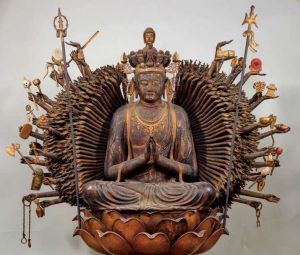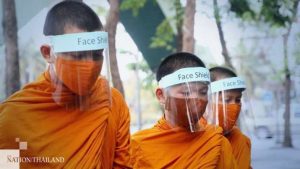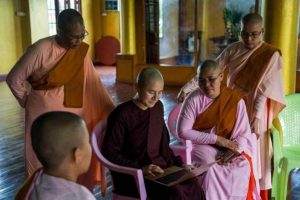Editor’s note: Bakaeva Elza Petrovna has a PhD in History and is Deputy Director of the Kalmyk Institute for Humanities of the Russian Academy of Sciences (Russian Federation, Republic of Kalmykia, Elista). In this article she highlights the ancient nature beliefs of the Buddhist Kalmyks, which centre around mountains and hills.
The Kalmyk people constitute a relatively young ethnicity, which was formed on the basis of ethnic Oirat groups who migrated at the beginning of the 17th century from Central Asia to the Volga region. According to written sources, the birthplace of the Oirats is Vosmirechye (Sekiz-Moron), which is the modern territory of the eastern part of the Republic of Tyva (Russian Federation) and Khubsugul aimag of Mongolia. This territory is located at the junction of the mountain-steppe and mountain-taiga regions. The question of when the Mongols’ ancestors appeared on the territory of modern Mongolia still remains open. There are suggestions that the ancestral home of the Mongol people were in middle [Kizlasov 1992: 134] or upper [Viktorova 1980: 161] areas of ??the Amur Regionor South Manchuria [Dashibalov, Rassadin 2004]. In the ancestral homeland as well as Western Mongolia, the forebears of the Kalmyks settled in mountainous areas that resulted in the worship of hills and mountains in their culture.
When the Oirats migrated into the Volga region, they found themselves dispersed across the territory to the north from the Caspian sea, where nomads settled both on the foothills and plains. Due to the limited number of places for nomads, the vast steppe territories started to become their main settlements. The present territory of the Republic of Kalmykia is divided into two parts: the eastern lowlands and western uplands with Ergeninskaya Hill.
The cult of mountains that formed in the traditional culture of the ancestors of the Kalmyk people was preserved in its modified form till the present day. The forms of mountain worship were preserved by the Kalmyks in several ways:
1. The worship of mountains appears most clearly in folklore. The epic tales describe the mountain as the center of nomads and as a symbol of the motherland. The mountain is called Mankhan Tsagan, which is said to be “a folded mountain” in honor of the ancient ancestral home. Its memory is preserved in folk songs and magtal, where the Kalmyks sing about their native settlements and their homeland (magtal is a folkoric piece of work that belongs to the genre of praise). The song named “Torgut Nutag” is well-known to all Oirats-Torguts. In the Kalmyk culture, it has been preserved as a part of the later songs, a primer dedicated to the First World War, where the warrior recalls his homeland. In modern Kalmyk culture, the song about Torgut Nutag was revived and is today performed by the well-known artist and composer Arkady Mandzhiev. It remains a popular song about the Kalmyks’ homeland. Specialmagtals in folklore are dedicated to the Altai and Khangai mountains as the ancient homeland of Kalmyks. Thus, such examples of folklore preserve the memory of the Oirats’ objects of worship – mountains (whether of mythic Mankhan Tsagan or real mountains like Altai and Khangai).
2. In the ritual culture of Kalmyks, the worship of mountains is preserved in two forms.
A) The worship of Bogdo, a real mountain, was traced to the appeared legends on the transferring of the mountain from its homeland by some monks. After, at the top of this mountain, Kalmyks erected “ova” – a mound of stones where all the Kalmyks used to conduct their worship. The mountain still remains the object of the worship and modern Kalmyks make pilgrimages to Bogdo.
B) Due to the absence of mountain areas, the cult of the mountains transformed into a cult of hill mounds (tolga) worship. According to U. E. Erdniev, “Kalmyks continued to deify mountains, stones, which, according to them, had their deities owners – ezen” [Erdniev 1970].
The meaning of the term ova in the Kalmyk language was preserved as heaps, piles, indicating the old interpretation of the term as a mound of stones, as a type of Mongolian and Oirat Oboo (oboo is a sacred place that represents either a mound of stones or a so-called “construction” of tree branches). However, in the steppes ova became known as mounds of stones as well as hills that still remain the place for the ancient rite of “ova tyakhe”.
In the steppe the ceremony of honoring the spirit-masters of the area was held as “ova tyakhe” on top of the hills, stone heaps and mounds. Usually it was only men who worshiped. At the top of the highest hill they placed a piece of a wooden bar, where they put a dough-made face of the deity Tsagan Aav, symbolizing the spirit-master of the area [Erdniev 1970].
Research on the worship ritual of ova allows the reconstruction of the ancient symbols associated with the origins of the cult of Tsagan Aav, who is also called Tsagan avga in the Kalmyk culture and has two main forms of worship: as Delkyan Tsagan Aav and as Gazar-usna Tsahan Aav.
Literature
Viktorova L.L. Mongoly. Proiskhozdeniye naroda i kulturi (Mongols. The origin of the people and of the culture). Moscow: Nauka, 1980.
Dashibalov B.B., Rassadin V.I. Otkuda vishli Mongoly? (Where Mongols originate from?). Vostochnaya colleczia (Oriental Collection). 2004. Number 4. S. 34-41.
Kizlasov L. R. Ocherki po istorii Sibiri I Tsentralnoy Azii (Essays of the History of Siberia and Central Asia). Krasnoyarsk: Isdatelstvo Krasnoyarskogo Universiteta, 1992.
Erdniev U. E. Kalmiki. Istorico-ethnographicheskiye ocherki (Kalmyks. Historical and ethnographic essays). Elista, 1970.










